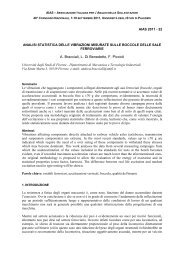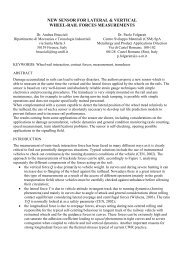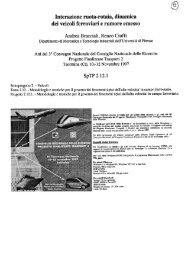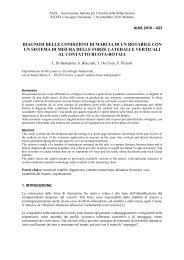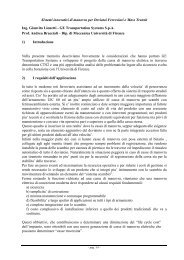LOW NOISE WHEEL - Home page Andrea Bracciali
LOW NOISE WHEEL - Home page Andrea Bracciali
LOW NOISE WHEEL - Home page Andrea Bracciali
Create successful ePaper yourself
Turn your PDF publications into a flip-book with our unique Google optimized e-Paper software.
• “Since December 2000 FS Trenitalia uses 16 wheels with Syope treatment on twoETR500 trainsets used for both tests and commercial service. We certify that thesetrainsets have been used up to 320 km/h and that up to now they have run approximately300.000 km without any problem due to the Syope treatment”.8. APPLICATION CASESLucchini presented at Innotrans 2002 in Berlin the results of the laboratory and line testsalready mentioned. At that time, the reconstruction process of the Merano-Malles line, alongthe Venosta valley on the Alps near the Austrian border, was at an advanced stage. The line,formerly managed by Italian State Railways FS, was closed in the early ‘90s as it wasconsidered not productive. The Autonomous Province of Bolzano decided to re-activate theline and was searching for a low environmental impact rolling stock. They finally chose aDMU articulated train manufactured by Stadler, Switzerland, that incorporates many state-ofthe-artsolutions. People in charge asked Lucchini to supply wheels with Syope ® treatment,and the line was finally opened on 5 May 2005 and immediately got a great success, graduallyalmost replacing the coach services along the valley.The train has the structure shown in Figure 9 and is capable of running at speed up to 100km/h. Trailing bogies are quite conventional and are equipped with Syope ® wheels (discbrakes on the axle), while the central motor car has brakes mounted on the wheel web, asolution that intrinsically offers a low noise. For new rolling stock of this kind (DMU), Italianlaws [17] require a maximum L pA,F of 83 dB(A) after 1/1/2002 and 81 dB(A) after 1/1/2012measured at 80 km/h with the microphone at 25 m from the track centreline (height=3.5 m).Figure 9: Stadler GTW 2/6 of Val Venosta regional railway.Tests were conducted on 12/13 July 2005 on a line section with a very limited slope ofapproximately 2‰, a condition that allowed measurement with full throttle climbing up toMalles and with engines off descending down to Merano. It was therefore possible to evaluatethe contribution of rolling noise to overall noise at full power.The highest maximum level of noise of 79.0 dB(A) was recorded during a 100 km/h fullpower run, while the noise at 80 km/h with both the engines off was stable around 74.0 dB(A)[18]. These values are much lower than what is currently requested by Italian law and willsatisfy also the requirements of 2012; moreover, the rolling noise contribution to the overallnoise is particularly limited (9 dB(A) less than 2002 limit, 5 dB(A) less than overall noise)and contributes only slightly to the noise pollution.Once again, what is satisfactory is the result obtained by a low speed regional train. It is worthto note that these results were obtained on a track with a roughness spectrum largely abovelimits stated by EN ISO 3095:2005.Another noticeable application was the supply of high speed trainsets of the “Pendolino” typeto Czech Railways. In 2000 Fiat Ferroviaria undertook an order of construction for ten tiltingtrains, but their number was then reduced to seven; the first set was delivered in 2004 asPendolino CD 680 (Figure 10). While testing from Breclav to Brno on November 18, 2004,the Pendolino reached a speed of 237 km/h and created a new Czech railway speed record.Since 2006 the service was extended to Slovakia and Austria.



